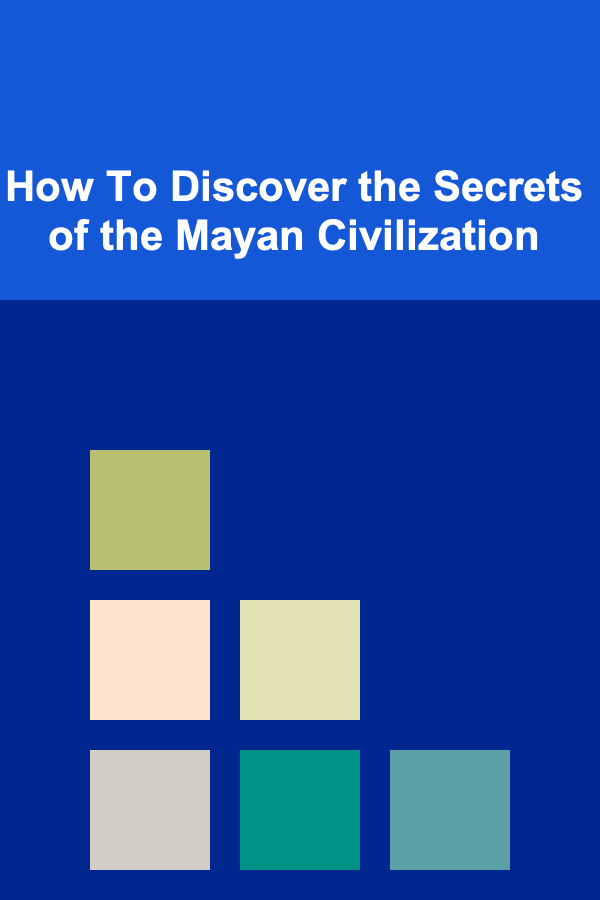
How To Discover the Secrets of the Mayan Civilization
ebook include PDF & Audio bundle (Micro Guide)
$12.99$10.99
Limited Time Offer! Order within the next:

The Mayan civilization, one of the most advanced and mysterious cultures of ancient Mesoamerica, has captivated historians, archaeologists, and adventurers for centuries. Known for their remarkable achievements in architecture, astronomy, mathematics, and writing, the Mayans left behind a rich legacy that continues to puzzle and fascinate scholars today. But the secrets of this ancient civilization are not easily unlocked, requiring a combination of advanced research methods, interdisciplinary approaches, and, in some cases, sheer determination.
In this article, we will explore how to discover the secrets of the Mayan civilization. We will delve into the history of the Mayans, the tools used to uncover their secrets, and how modern technology is helping researchers peel back the layers of this fascinating culture. Whether you are a curious student of history or an aspiring archaeologist, this guide will offer insights into the methodologies and challenges involved in uncovering the mysteries of the ancient Maya.
The Mayan Civilization: A Brief Overview
Before diving into the methods used to uncover their secrets, it's important to understand who the Mayans were and why their civilization remains so enigmatic. The Mayan civilization thrived in Mesoamerica, spanning modern-day Mexico, Guatemala, Belize, Honduras, and El Salvador. It developed over several thousand years, reaching its peak during the Classic Period (250 to 900 AD).
The Maya were an advanced society with sophisticated knowledge in many areas. Their cities, including Tikal, Copán, Palenque, and Chichen Itza, were marvels of engineering, featuring massive pyramids, temples, palaces, and ball courts. The Mayans had a complex religious and political system, with rulers, priests, and scribes playing pivotal roles in society.
One of the most remarkable aspects of Mayan culture was their writing system, which included both logograms and syllabic symbols, known as hieroglyphs. They also developed an intricate calendar system that was remarkably accurate and based on astronomical observations.
However, despite the Mayans' advancements, much of their civilization's decline remains shrouded in mystery. By the end of the 9th century, many southern cities were abandoned, and the reasons for their collapse are still debated. Understanding how to unlock the secrets of the Maya requires piecing together fragments of knowledge from various fields of study.
Unveiling the Secrets of the Mayan Civilization: The Tools and Approaches
The process of uncovering the secrets of the Mayan civilization is a multifaceted one, involving various research methods. These methods include archaeological digs, linguistic analysis, the use of modern technology, and the interpretation of ancient texts. In this section, we will explore how these tools are employed in the quest to discover the Mayan civilization's secrets.
1. Archaeological Excavation
Archaeology is one of the most essential tools for discovering the secrets of ancient civilizations, including the Mayans. Archaeologists conduct digs to uncover buried artifacts, buildings, and other remnants of Mayan culture. These excavations help researchers piece together the daily life, religion, and politics of the Maya.
The Role of Excavation in Understanding Mayan Architecture
One of the primary focuses of archaeological digs is the Mayan architecture, which includes monumental pyramids, temples, palaces, and other structures. These buildings often contain important inscriptions and artwork that provide clues about the civilization's rulers, deities, and cosmology.
For example, the city of Copán in Honduras has been the subject of extensive excavations. Researchers have uncovered a series of intricate stelae (stone monuments) that depict Mayan rulers and their achievements. These stelae often include hieroglyphic inscriptions that help to identify specific historical events and leaders.
Excavations also help to reveal the layout of Mayan cities, which were carefully planned and often aligned with astronomical phenomena. In some cases, the orientation of buildings and plazas was designed to align with celestial events such as solstices and equinoxes. These findings offer insight into the Maya's understanding of astronomy and their religious practices.
2. The Study of Mayan Hieroglyphs
One of the most significant breakthroughs in understanding Mayan culture came with the deciphering of Mayan hieroglyphs. For centuries, scholars struggled to understand the complex writing system, but in the 20th century, breakthroughs in linguistics led to the partial decipherment of the script.
Mayan hieroglyphs were a combination of logograms (symbols representing words or concepts) and syllabic signs (representing sounds). This combination made the system complex but also allowed it to represent a wide range of ideas and sounds.
The decipherment of Mayan hieroglyphs is ongoing, but major progress has been made, especially with the work of linguists such as Yuri Knórosov and David Stuart. One of the most significant achievements in this field was the identification of the Maya's historical records, which were often carved into stone stelae or written on codices made of bark paper.
Mayan hieroglyphs have revealed much about Mayan rulers, their rituals, and their relations with other city-states. These inscriptions have allowed researchers to understand the political dynamics of the Maya, the names of specific rulers, and the historical events that shaped their world.
The Role of Codices in Mayan Research
In addition to stone inscriptions, Mayan codices---folded books made from bark paper---are a crucial source of knowledge. These codices contain a wealth of information, including detailed calendars, astronomical observations, and religious rituals. Unfortunately, many Mayan codices were destroyed during the Spanish conquest, but a few survived, such as the Dresden Codex, which is one of the most important surviving examples of Mayan writing.
3. The Use of Modern Technology
While traditional methods like excavation and textual analysis remain crucial, modern technology has revolutionized the study of the Mayan civilization. Remote sensing technologies, such as LiDAR (Light Detection and Ranging), have allowed researchers to map and explore previously inaccessible areas of Mayan cities and jungles.
LiDAR Technology: Mapping the Hidden Cities
LiDAR technology uses laser pulses to measure distances and create high-resolution 3D maps of the ground beneath dense vegetation. This technology has been a game-changer in the study of the Mayan civilization, as it has revealed thousands of previously hidden structures in the jungles of Guatemala and Mexico.
In 2018, a team of researchers used LiDAR to map the ancient city of Tikal, revealing a network of over 60,000 structures that were previously unknown. These discoveries have changed our understanding of Mayan society, showing that their cities were much larger and more complex than previously thought.
LiDAR technology is also helping to uncover the layout of Mayan cities, including their road systems, water management infrastructure, and agricultural terraces. These findings have provided new insights into the Maya's urban planning and environmental management practices.
Ground-Penetrating Radar (GPR)
Another powerful technology used to explore Mayan sites is ground-penetrating radar (GPR). GPR uses electromagnetic waves to detect objects and structures beneath the surface. This method is particularly useful for identifying buried structures, such as tombs, walls, and other features, without the need for extensive excavation.
GPR has been used to investigate the Maya city of Calakmul in Mexico, where researchers have uncovered hidden chambers and corridors within the massive pyramids. These non-invasive techniques are helping to preserve Mayan sites while also expanding our knowledge of their architecture and burial practices.
4. Environmental and Ecological Studies
Understanding the environmental context in which the Mayan civilization flourished is crucial to discovering their secrets. Researchers study the climate, flora, and fauna of ancient Mesoamerica to better understand how the Maya interacted with their environment.
Deforestation and the Collapse of the Maya
One of the most significant environmental factors that researchers are studying is deforestation. The Maya were skilled agriculturalists, using slash-and-burn techniques to clear land for farming. However, evidence suggests that over time, extensive deforestation led to soil degradation and reduced agricultural productivity, which may have contributed to the collapse of the southern Maya lowlands.
Paleoclimatic studies, including the analysis of tree rings, ice cores, and sediment layers, have provided evidence of severe droughts that may have coincided with the decline of the Mayan civilization. These environmental changes, coupled with social and political factors, may have played a crucial role in the collapse of the Classic Maya civilization in the 9th century.
5. Interdisciplinary Collaboration
Finally, the discovery of the secrets of the Mayan civilization requires an interdisciplinary approach. Archaeologists, linguists, historians, environmental scientists, and even mathematicians all contribute to the ongoing investigation of the Maya. Collaborative efforts between institutions and researchers from different fields are essential to piecing together the complex puzzle of Mayan society.
For example, archaeologists and linguists work together to interpret Mayan inscriptions, while environmental scientists analyze soil samples and study the effects of climate change. By combining expertise from multiple disciplines, researchers can gain a more comprehensive understanding of the Maya and their civilization.
Conclusion
Discovering the secrets of the Mayan civilization is a complex and ongoing process that requires a combination of traditional research methods and cutting-edge technology. Through archaeological excavation, the study of Mayan hieroglyphs, the use of modern tools like LiDAR and GPR, and interdisciplinary collaboration, scholars are slowly but surely uncovering the mysteries of this fascinating culture.
As we continue to study the Maya, we gain valuable insights not only into their civilization but also into the broader history of human development. The secrets of the Mayans may never be fully revealed, but with each new discovery, we draw closer to understanding the remarkable achievements of one of the greatest ancient civilizations.

Becoming a Successful Health Coach: Essential Skills for Client-Centered Success
Read More
How to Create a Pet-Friendly Bathroom Setup
Read More
How to Maximize Storage in Tiny Bathrooms
Read More
How to Use LinkedIn Events to Promote B2B Dropshipping Webinars and Networking Opportunities
Read More
Top Interview Questions and How to Answer Them Effectively
Read More
How To Discover Award-Winning TV Series
Read MoreOther Products

Becoming a Successful Health Coach: Essential Skills for Client-Centered Success
Read More
How to Create a Pet-Friendly Bathroom Setup
Read More
How to Maximize Storage in Tiny Bathrooms
Read More
How to Use LinkedIn Events to Promote B2B Dropshipping Webinars and Networking Opportunities
Read More
Top Interview Questions and How to Answer Them Effectively
Read More